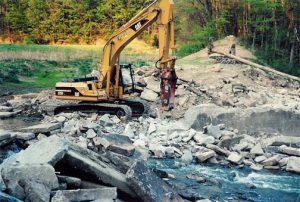China’s work to preserve and revive its forests and wetlands by paying individuals and communities to look after them signals the country’s rise as an environmental innovator.
But it also points to the “multiple personalities” of the Chinese government, says Michael Bennett, contributor to State of Watershed Payments 2012, published by Forest Trends this month. China leads the world in adoption of these subtle, low-cost ways to protect water resources, yet at the same time it is building a US$62 billion mega-engineering scheme to pump water from the south of the country to the arid north.
Acute water shortages in China are driving unprecedented attention and investment in watershed protection, explains Bennett, an environmental economist based in Beijing, who has also worked for the Asian Development Bank and Center for Chinese Agricultural Policy.
By any measure, the situation is bleak. In the past 40 years, 13% of China’s lakes have disappeared, half its coastal wetlands have been lost to reclamation and 50% of cities left without drinking water that meets acceptable hygiene standards, according to WWF. The UN has singled China out as one of 13 countries with extreme water shortages.
Pollution and groundwater depletion driven by decades of economic boom have compounded problems in a nation already cursed by inconvenient distribution of water – though the south of the country has relatively abundant resources, per capita water in Beijing for example is one tenth the global average.
All of this, says Bennett, has “concentrated the minds of central government”, which has committed to spending around 4 trillion yuan (US$643 billion) by 2020 on water management, conservation and infrastructure. What the authorities call “ecosystem compensation” is core to the water strategy outlined in the 12th Five-Year Plan, the country’s development blueprint to 2015.
This includes payment for ecosystem services (PES) – where farmers and landowners are given financial incentives to manage their land in ways that, for example, provide clean water to communities downstream or forest services – as well as getting richer regions of China that benefit from ecosystems elsewhere, to cough up cash in recognition of that.
China is already leading the world in PES, according to the Forest Trends report, accounting for 91% of the 2011 watershed investments the study documents. In one scheme highlighted by the authors, the Chinese authorities provide health insurance benefits to 108,000 people upstream of the southern city of Zhuhai in exchange for managing their land in a way that will improve drinking water for the region.
For Bennett, this is an example of how China is becoming a global hub of environmental experimentation, contrary to a common view – both inside and outside China – that the country’s best bet on conservation is to learn from research and experience of the rest of the world.
Many other countries are struggling with similar issues, not least the United States which, despite comparatively abundant water resources and low population density, is facing something of a water crisis: 36 states are anticipating water shortages this year, according to the US government.
“What I find exciting about work in China is that the solutions that the government will come up with here will be pretty applicable in the rest of the world,” says Bennett. “But I find when I’m having these conversations with [Chinese] officials, they’re really fixated on international experience. The next phase is to really get at what’s happening on the ground here and identify some of these innovative approaches, not only to teach other parts of China, but the rest of the world as well.”
Concerns about rural welfare
There are still challenges that need to be worked through at home, however. Fragmentation of responsibility across a tangled web of water-management bodies, weak environmental laws, ambiguous property rights and different agendas on the parts of central and local government can all get in the way of progress, says Bennett.
China’s “sloping land conversion programme” offers an example. One of the world’s largest aforestation schemes, it pays subsidies (fairly generous at around US$300 per hectare) directly to rural households for converting marginal or sloping cropland to either forest or grassland. Founded in 1999 to target the Yangtze and Yellow River watersheds, it has since scaled-up at enormous speed, and now covers much of the country.
Though seen as a success story overall, the programme has raised concerns about rural welfare as different local authorities have implemented differently: “In principle the programme is voluntary,” says Bennett. “But in some places households didn’t have a choice in whether or not they were going to participate and there have been some issues about whether they were actually compensated according to their opportunity cost for the retired land.” The government has committed to improving the scheme in the 12th Five-Year Plan period.
“My heart is really out for the leadership trying to come up with solutions because China’s just so maddeningly complex,” says Bennett. “The trend is in the right direction, the question is whether it’s going to be fast enough.”
Still pouring concrete
One pressing question is whether the elements of government pushing for a continued emphasis on heavy engineering can be tamed. As impressive as China’s efforts to preserve its water resources may be, recent history holds a litany of controversial water-management schemes: the Three Gorges Dam, the South-North water transfer scheme and even an idea to pump sea water from the Bohai Gulf to Inner Mongolia to feed thirsty coal plants.
The South-North project currently tops the list. This Mao-era dream to divert water north from the Yangtze River, now under construction, has been criticised by economists and environmentalists for its expense, impacts on agriculture and mass relocations of communities, among other issues. Many, including Bennett, argue the government would do better to reform water pricing so that downtown hotels in parched Beijing no longer gush water from grand fountains, or golf courses guzzle resources keeping their courses green.
“The government has multiple personalities and one of them is obviously this pour more cement, create more infrastructure to solve water problems kind of approach,” says Bennett. “But there’s definitely a growing voice that says no, we need to price water accordingly, we need to invest proactively in improving the efficiency of how we use water.”



